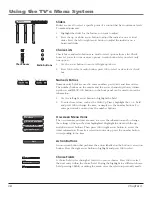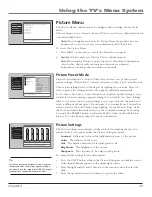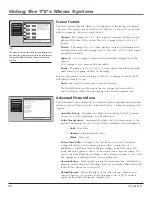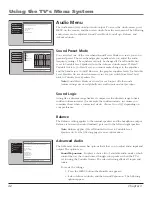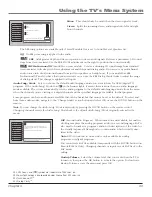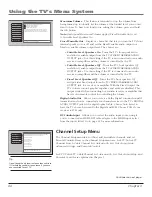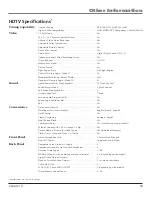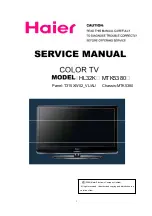
Other Information
Chapter
• If you’ve connected a device to your A/V receiver, such as a DVD player
or satellite receiver, you may experience a slight delay
between the audio heard and the video seen. This occurs because the digital audio is sent directly to the speakers while the video
must be processed inside the TV before it is displayed.
• If the device has Component Video (Y, Pb, Pr) jacks, connect these jacks to the TV’s Y, Pb, Pr jacks to minimize the discrepancy. This
works best if the device supports Progressive Scan technology.
• If necessary, you can connect the device directly to the TV using L/R audio jacks and bypassing the A/V receiver or you can program
an audio delay in the A/V receiver so the audio and video match up (not all audio equipment has the ability to program delays).
Check the Audio/Video Receiver’s manual.
Blank screen
• Make sure you have connected the device to the TV correctly.
• Make sure the device connected to the TV is turned on and tuned to the corresponding Video Input Channel.
• Try another channel, or press the INPUT or ANT•CAB button.
• When you first turn off your TV, the screen fades from blue to black. Once the screen goes black, the TV’s internal lamp starts its
cool-down cycle. If you try to turn on the TV during the cool-down cycle, the TV turns back on and you’ll hear audio, but the
picture will take a few moments to be displayed.
Unusual sound quality
• Check the
Graphic Equalizer
,
Sound Expansion, SAP
and
Sound Logic
settings.
• Check if SAP is turned on.
• Check that the
Audio Lang./ Mode
or
SAP
is set to your language.
Humming or buzzing noise
• The TV is in its lamp cool-down cycle. To prolong the life of the TV’s lamp system, the TV must warm up and cool down properly.
You may notice additional noise during these cycles.
• Maybe the speakers are turned off. Check the
FIXED/VARIABLE OUT
control panel in the
Audio
menu.
no picture, sound okay
• If the indicator on the front of the TV is blinking for one minute, the lamp inside of your TV may need to be changed. Refer to the
Power indicator is blinking or flashing
section on the previous page for more information.
• You might have tried to turn on the TV during lamp cool-down. Wait a few moments and the picture will be displayed.
no sound, picture okay
• Maybe the sound is muted. Try pressing the volume up button to restore sound.
• Maybe the speakers are turned off in the
Audio
menu. Check the
FIXED/VARIABLE OUT
control panel in the
Advanced Audio
menu.
• If using an S-Video, component or composite video connection, remember to also connect the device’s L and R AUDIO OUT jacks to
the TV’s L and R INPUT jacks.
• Check the
Maximum Volume
and
Startup Volume
settings in the
Advanced Audio
menu.
Channel search finds few channels
• The cable connected to the CABLE and/or ANTENNA INPUT jack might be loose.
• Your off-air antenna might be getting a weak signal. Move it higher or get a bigger antenna.
• If you have cables connected to the CABLE and ANTENNA jacks, try swapping the cables. Cable needs to be connected to the CABLE
INPUT; off-air antenna needs to be connected to the ANTENNA INPUT.
• If you have a cable box, you can’t connect it to the ANTENNA jack. Connect it to the CABLE INPUT or a Video Input jack.
• Select all the options in the
Channel Search
menu, and retry channel search.
Can’t select certain channel
• May be blocked or not approved in the
Parental Controls
menu.
• If using a VCR, check to make sure the TV/VCR button on the VCR is in the correct mode (press the TV/VCR or INPUT button on
your VCR).
• You usually can’t change channels when a menu is on the screen (press the CLEAR button).
• You might need to reset your digital cable card if you have one installed. for more instructions.


